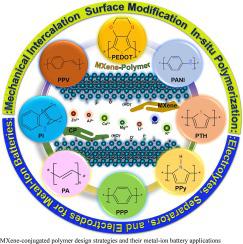当前位置:
X-MOL 学术
›
Coord. Chem. Rev.
›
论文详情
Our official English website, www.x-mol.net, welcomes your feedback! (Note: you will need to create a separate account there.)
Flexible MXene-conjugated polymer nanoarchitectures: Current developments and future frontiers in battery technology
Coordination Chemistry Reviews ( IF 20.6 ) Pub Date : 2024-04-01 , DOI: 10.1016/j.ccr.2024.215778 Sowjanya Vallem , Sada Venkateswarlu , Seunghyun Song , Jihyun Kim , Yang Li , Joonho Bae
Coordination Chemistry Reviews ( IF 20.6 ) Pub Date : 2024-04-01 , DOI: 10.1016/j.ccr.2024.215778 Sowjanya Vallem , Sada Venkateswarlu , Seunghyun Song , Jihyun Kim , Yang Li , Joonho Bae

|
The development of flexible nanomaterials for metal-ion batteries (MIBs) is important for ever-growing electrochemical energy-storage technologies. MXenes are a novel class of conductive two-dimensional nanomaterials with abundant active sites favorable for pseudocapacitive energy storage due to their wide interlayer spacing and active surface functionalities, enabling the easy intercalation of numerous metal ions. However, MXenes face the severe challenges of self-stacking and agglomeration, leading to low electrochemical kinetics and capacity deterioration. On the other hand, conjugated polymers (CPs) play a significant role in MIBs owing to their high structural flexibility, ionic conductivity, lightweight, and exceptional processability. However, they suffer from structural degradation in long-term practical use, hindering the electrochemical operation of MIBs. Therefore, MXene in conjunction with CPs can alleviate the aggregation of MXene, which can provide structural strength to the polymers. Furthermore, owing to their surface functional groups, MXene-conjugate polymer (MX-CP) composites can offer greater control over the physical and chemical characteristics of MXene. The addition of CPs enhances the energy-storage capability of MXene by expanding the interlayer gap, reducing the ion/electron transport distance, and improving surface hydrophilicity. In this review, we discussed recent advances in MX-CP nanoarchitectures developed for MIBs, the synthesis strategies, and the influence of MX-CP structures to enhance electrochemical properties, challenges, scientific solutions, as well as future perspectives. This review can motivate researchers to develop flexible MX-CPs for sustainable electrochemical energy storage (EES).
中文翻译:

柔性 MXene 共轭聚合物纳米结构:电池技术的当前发展和未来前沿
用于金属离子电池(MIB)的柔性纳米材料的开发对于不断发展的电化学储能技术非常重要。 MXene 是一类新型导电二维纳米材料,具有丰富的活性位点,由于其宽的层间距和活性表面功能,有利于赝电容储能,可以轻松嵌入大量金属离子。然而,MXene面临着自堆积和团聚的严峻挑战,导致电化学动力学低和容量退化。另一方面,共轭聚合物(CP)由于其高结构灵活性、离子电导率、轻质和优异的加工性能,在 MIB 中发挥着重要作用。然而,它们在长期实际使用中会出现结构退化,阻碍了MIB的电化学操作。因此,MXene与CPs结合可以减轻MXene的聚集,从而为聚合物提供结构强度。此外,由于其表面官能团,MXene-共轭聚合物(MX-CP)复合材料可以更好地控制 MXene 的物理和化学特性。 CP的添加通过扩大层间间隙、减少离子/电子传输距离和提高表面亲水性来增强MXene的储能能力。在这篇综述中,我们讨论了为 MIB 开发的 MX-CP 纳米结构的最新进展、合成策略、MX-CP 结构对增强电化学性能的影响、挑战、科学解决方案以及未来前景。该综述可以激励研究人员开发用于可持续电化学储能(EES)的灵活 MX-CP。
更新日期:2024-04-01
中文翻译:

柔性 MXene 共轭聚合物纳米结构:电池技术的当前发展和未来前沿
用于金属离子电池(MIB)的柔性纳米材料的开发对于不断发展的电化学储能技术非常重要。 MXene 是一类新型导电二维纳米材料,具有丰富的活性位点,由于其宽的层间距和活性表面功能,有利于赝电容储能,可以轻松嵌入大量金属离子。然而,MXene面临着自堆积和团聚的严峻挑战,导致电化学动力学低和容量退化。另一方面,共轭聚合物(CP)由于其高结构灵活性、离子电导率、轻质和优异的加工性能,在 MIB 中发挥着重要作用。然而,它们在长期实际使用中会出现结构退化,阻碍了MIB的电化学操作。因此,MXene与CPs结合可以减轻MXene的聚集,从而为聚合物提供结构强度。此外,由于其表面官能团,MXene-共轭聚合物(MX-CP)复合材料可以更好地控制 MXene 的物理和化学特性。 CP的添加通过扩大层间间隙、减少离子/电子传输距离和提高表面亲水性来增强MXene的储能能力。在这篇综述中,我们讨论了为 MIB 开发的 MX-CP 纳米结构的最新进展、合成策略、MX-CP 结构对增强电化学性能的影响、挑战、科学解决方案以及未来前景。该综述可以激励研究人员开发用于可持续电化学储能(EES)的灵活 MX-CP。



























 京公网安备 11010802027423号
京公网安备 11010802027423号